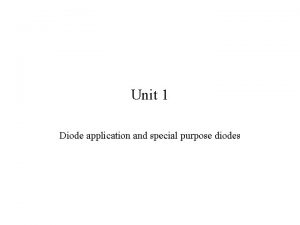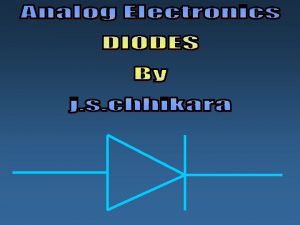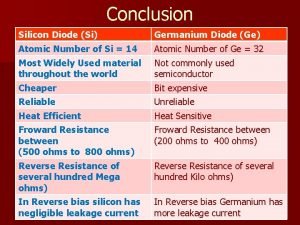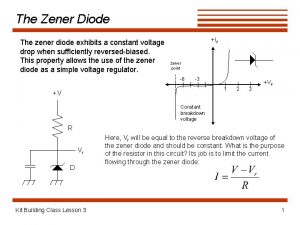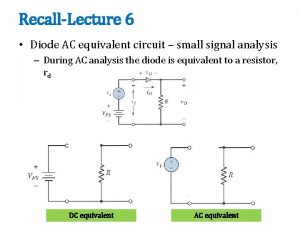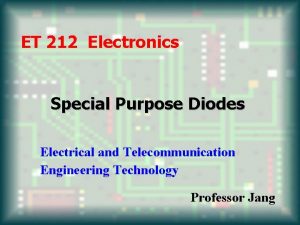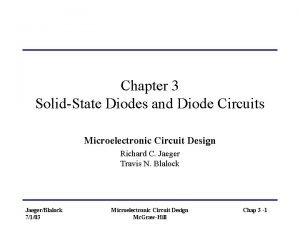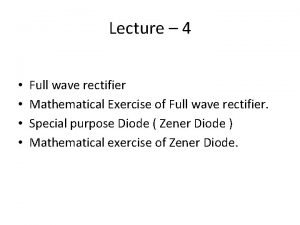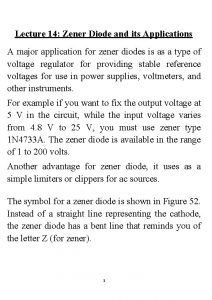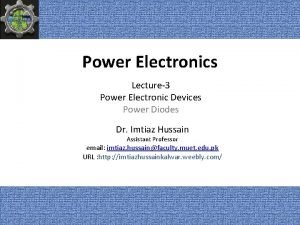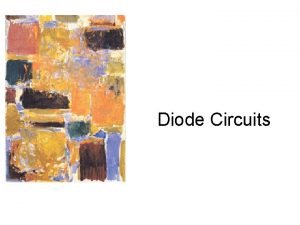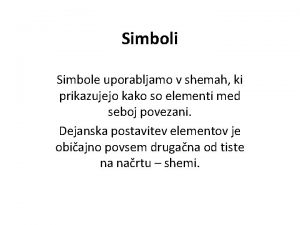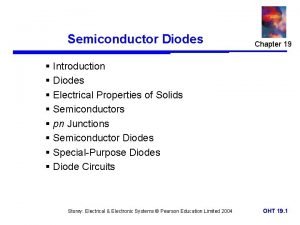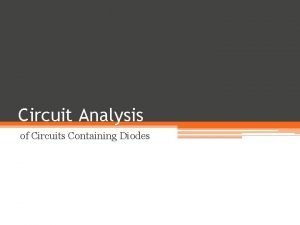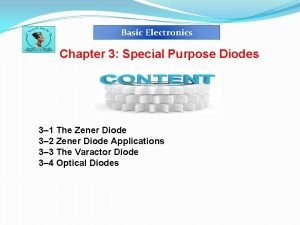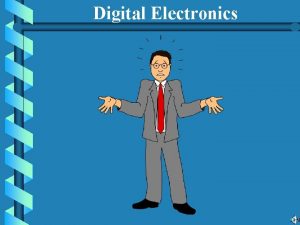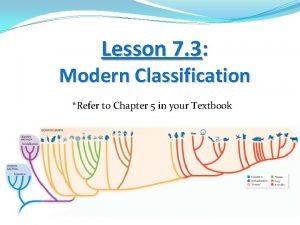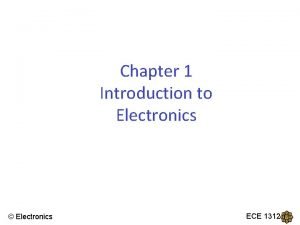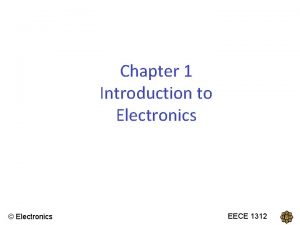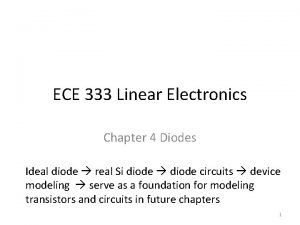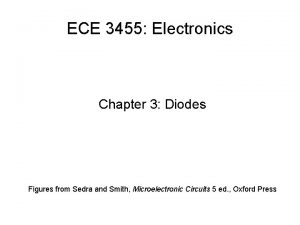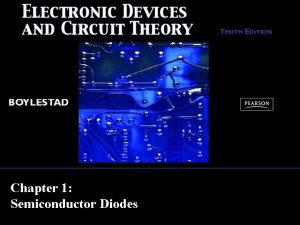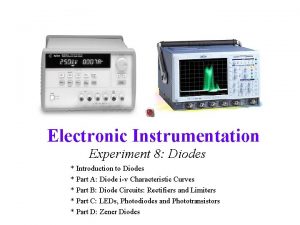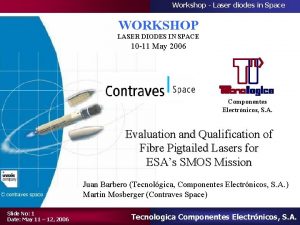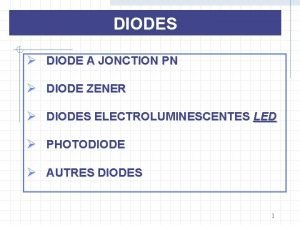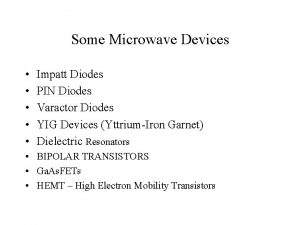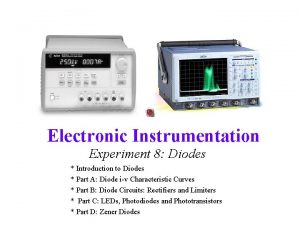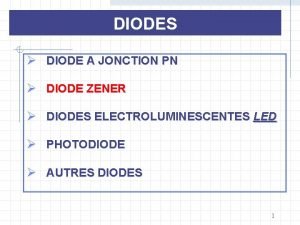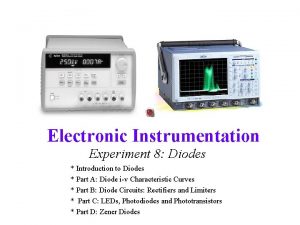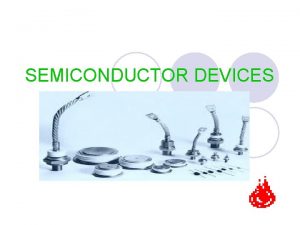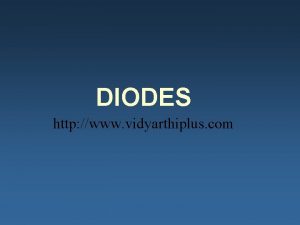Chapter 2 Diodes Electronics ECE 1312 Classification of




















- Slides: 20

Chapter 2 Diodes © Electronics ECE 1312

Classification of Materials Classification according to the way materials react to the current when a voltage is applied across them: l Insulators Ø Materials with very high resistance - current can’t flow Ø mica, rubber l Conductors Ø Materials with very low resistance – current can flow easily Ø copper, aluminum l Semiconductors Ø Neither good conductors nor insulators (silicon, germanium) Ø Can be controlled to either insulators by increasing their resistance or conductors by decreasing their resistance © Electronics ECE 1312

Semiconductor Materials and Properties ● An atom is composed of a nucleus, which contains positively charged protons and neutral neutrons, and negatively charged electrons that orbit the nucleus. ● Electrons in the outermost shell are called valence electrons. © Electronics ECE 1312

A portion of the periodic table in which the more common semiconductors are found ● Elemental Semiconductors Silicon (Si) and germanium (Ge) are in group IV. Hence, they have 4 electrons in their outer shells Do you still remember? A stable atoms need 8? electrons at its outermost shell © Electronics ECE 1312

• Si have 4 electrons in their outer shells • needs another 4 to become stable • So, when there are 4 other Si nearby = 4 electrons: Si Si Sharing of electrons occurred; and this bond is known as the covalent bond Si ● Atoms come into close proximity to each other and so the valence electrons interact to form a crystal. © Electronics ECE 1312

BANDGAP ENERGY, Eg • Now, in order to break the covalent bond, a valence electron must gain enough energy to become free electrons. • The minimum energy required is known as the bandgap energy, Eg © Electronics ECE 1312

ILLUSTRATION WHEN A VALENCE ELECTRON IS FREE 1. Becomes free electron 3. Electron moves to fill space 5. Electron moves to fill space 2. Becomes empty 4. Becomes empty © Electronics ECE 1312

Intrinsic Semiconductor ● Intrinsic Semiconductor Ø A single-crystal semiconductor material with no other types of atoms within the crystal. Ø The densities of electrons and holes are equal. Ø The notation ni is used as intrinsic carrier concentration for the concentration of the free electrons as well as that of the hole: B = a coefficient related to the specific semiconductor material Eg = the bandgap energy (e. V) T = the temperature (Kelvin) remember that K = °C + 273. 15 k = Boltzmann’s constant (86 x 10 -6 e. V/K) © Electronics ECE 1312

Intrinsic Semiconductor ● The values of B and Eg for several semiconductor materials: Example: Calculate the intrinsic carrier concentration in silicon at T = 300 K. © Electronics ECE 1312

• Example 2 Find the intrinsic carrier concentration of Gallium Arsenide at temperature = 300 K k = Boltzmann’s constant (86 x 10 -6 e. V/K) Answer: 1. 8 x 106 cm-3 © Electronics ECE 1312

Example 3 Answer: 1. 4 e. V © Electronics ECE 1312

Extrinsic Semiconductor • Since intrinsic concentration, ni is very small, so, very small current is possible • So, to increase the number of carriers, impurities are added to the Silicon/Germanium. • The impurities will be from Group V and Group III © Electronics ECE 1312

Extra electron • Group V – 5 electrons in the outer shell; Example, Phosphorus, Arsenic • The 5 th electron are loosely bound to the Phosphorus atom • Hence, even at room temperature, the electron has enough energy to break away and becomes free electron. • Atoms from Group V are known as donor impurity (because it donates electrons) Group V + Si = n-type semiconductor © Electronics ECE 1312

Extra hole • Group III – 3 electrons in the outer shell; Example, Boron • The valence electron from outer shells are attracted to fill the holes added by the insertion of Boron • Hence, we have movement of holes • Atoms from Group III are known as acceptor impurity (because it accept electrons) Group III + Si = p-type semiconductor © Electronics ECE 1312

– The materials containing impurity atoms are called extrinsic semiconductors, or doped semiconductors. – Effects of doping process • controls the concentrations of free electrons and holes • determines the conductivity and currents in the materials. – The relation between the electron and hole concentrations in thermal equilibrium: no = thermal equilibrium concentration of free electrons po = thermal equilibrium concentration of holes ni = the intrinsic carrier concentration © Electronics ECE 1312

For N-type – electrons are the majority carriers Ø At room temperature (T = 300 K), each donor atom donates a free electron to the semiconductor. • If the donor concentration Nd is much larger than the intrinsic concentration, approximately: • Then, the hole concentration: © Electronics ECE 1312

For P-type – holes are the majority carriers Ø Similarly, at room temperature, each acceptor atom accepts a valence electron, creating a hole. • If the acceptor concentration Na is much larger than the intrinsic concentration, approximately: • Then, the electron concentration: © Electronics ECE 1312

Example 1 Calculate thermal equilibrium electron and hole concentrations. Consider silicon at T = 300 K doped with phosphorous at a concentration of Nd = 1016 cm-3 and ni = 1. 5 x 1010 cm-3. © Electronics ECE 1312

Example 2 Calculate the majority and minority carrier concentrations in silicon at T = 300 K if a) b) Na = 1017 cm-3 Nd = 5 x 1015 cm-3 1. Calculate ni 2. For part (a) – it is p-type 3. For part (b) – it is n-type Answer: a) majority = 1017 cm-3 minority 2. 25 x 103 cm-3 b) Majority 5 x 1015 cm-3, minority 4. 5 x 104 cm-3 © Electronics ECE 1312

k = Boltzmann’s constant (86 x 10 -6 e. V/K) • EXAMPLE 1 • EXAMPLE 2 Calculate the intrinsic A silicon is doped with 5 x 1016 carrier concentration arsenic atoms of Silicon at T = 250 K a) Is the material n-type or p-type? Answer: ni = 1. 6 x 108 cm-3 © Electronics b) Calculate the electrons and holes concentration of the doped silicon at T=300 K Answer: a) n-type b) no = 5 x 1016 cm-3 and po = 4. 5 x 103 cm-3 ECE 1312
 Ang timbukto ay naging isang malaking lungsod pangkalakalan
Ang timbukto ay naging isang malaking lungsod pangkalakalan Diodes
Diodes Special purpose diode
Special purpose diode What are diodes made out of
What are diodes made out of Silicon diode characteristics
Silicon diode characteristics Zener diode exhibit
Zener diode exhibit Zener diode equivalent circuit models
Zener diode equivalent circuit models What are special purpose diodes
What are special purpose diodes Solid state rectifier circuit diagram
Solid state rectifier circuit diagram Full wave rectification
Full wave rectification Zener diode application
Zener diode application Power diodes types
Power diodes types Vt diode
Vt diode Termistor simbol
Termistor simbol Introduction to diodes
Introduction to diodes Circuit analysis with diodes
Circuit analysis with diodes Special purpose diodes
Special purpose diodes Digital electronics chapter 1
Digital electronics chapter 1 Eager learning algorithm
Eager learning algorithm Qualitative classification in statistics
Qualitative classification in statistics Traditional classification vs modern classification
Traditional classification vs modern classification


